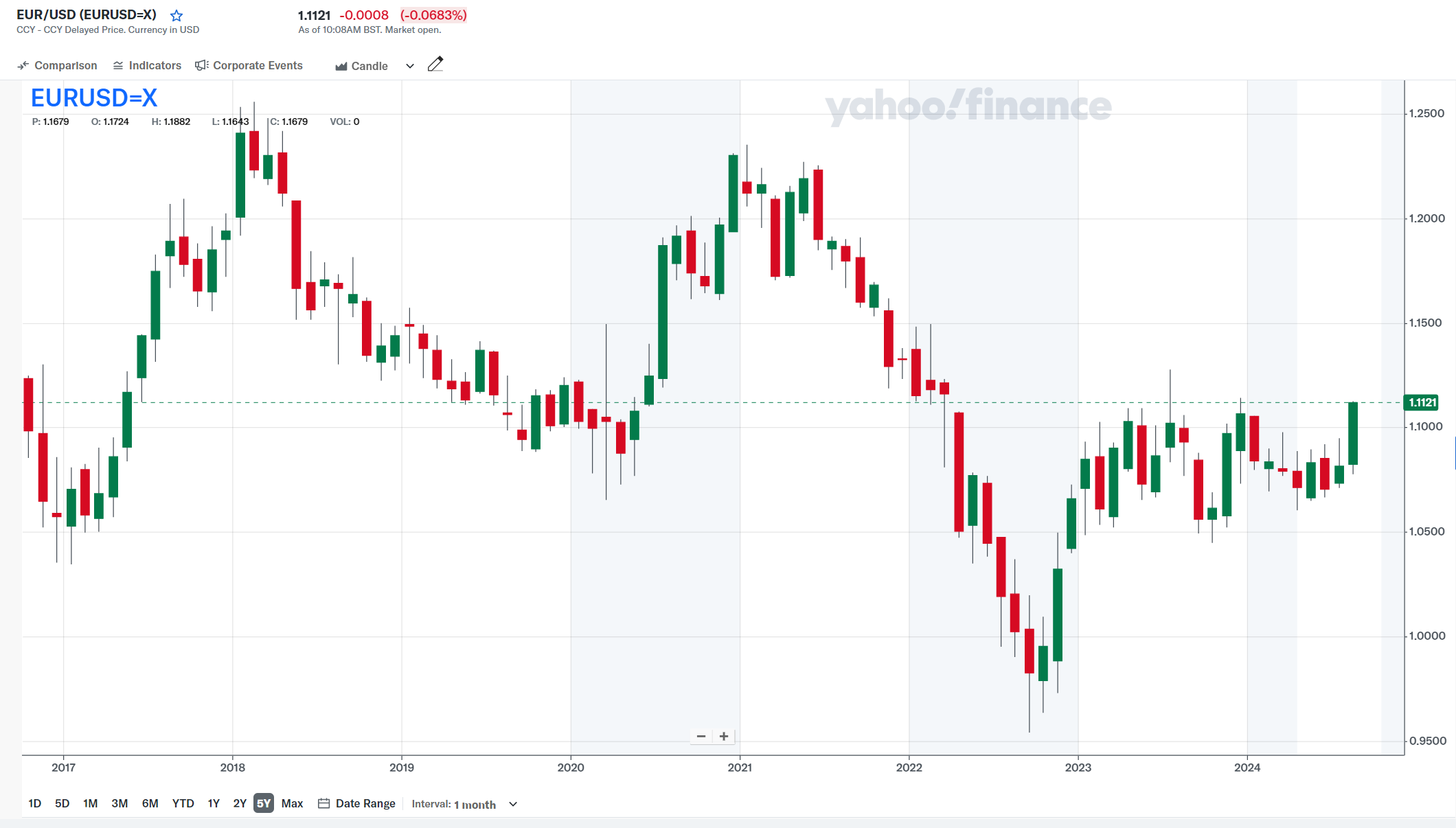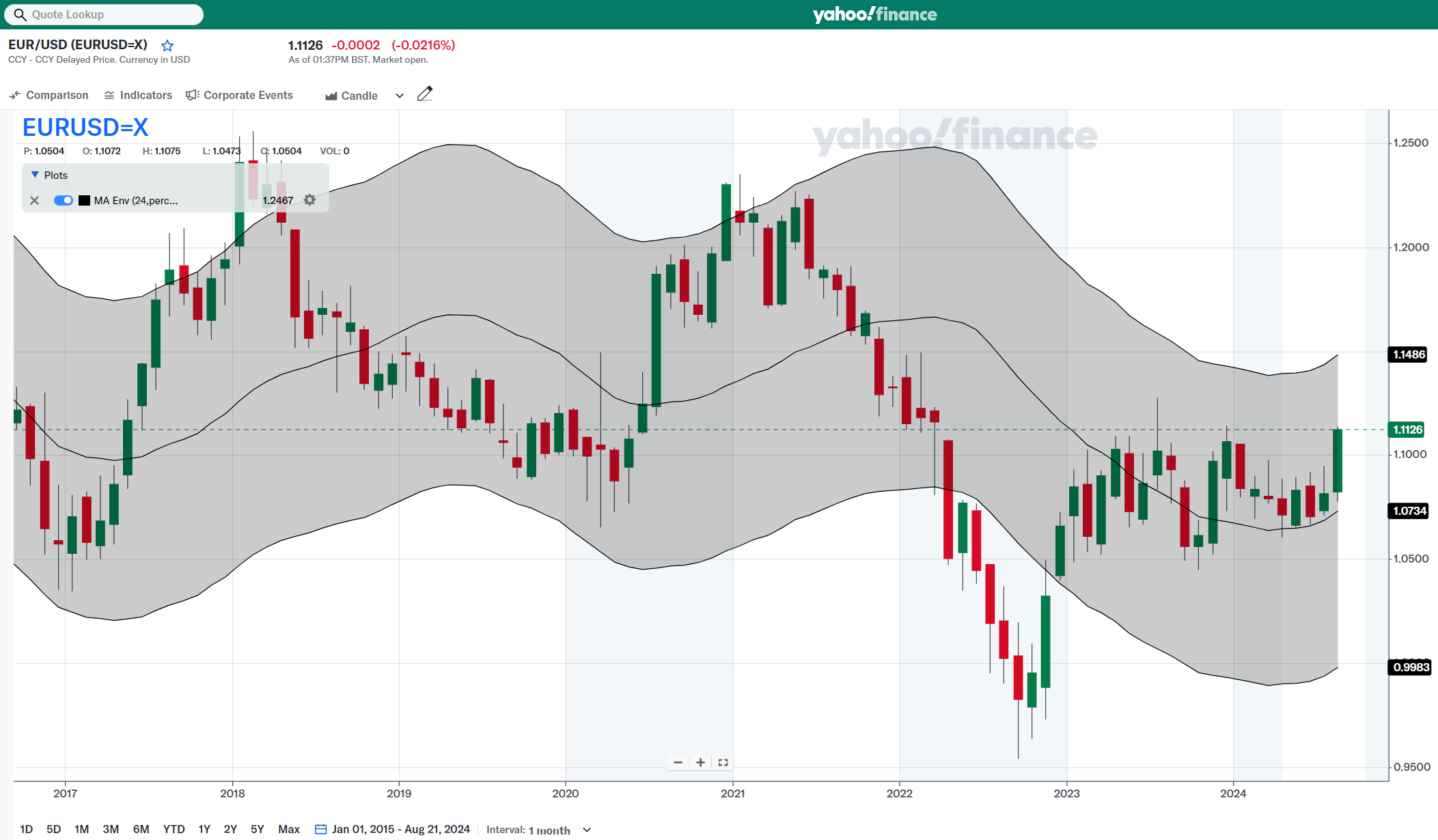EURUSD Forecast August 2024: Is a Breakout Ahead


August 2024 is a surprisingly eventful month, defying the usual expectation of a quiet vacation. However, as we explore the EURUSD Forecast August 2024, it’s clear that markets never truly take a break. With volatility sweeping across all sectors, the USD is shifting noticeably, so we’re focusing on the EURUSD pair.
Our previous EURUSD Forecast was published almost a year ago, on September 2023. While that analysis is still relevant, this update will take a fresh look at the EURUSD from a different perspective, reflecting the current market dynamics.
Historical Context: EURUSD Trends Over the Last Eight Years
If you look at the chart of EURUSD for the last 8 years, courtesy of Yahoo Finance, it would be reasonable to assume that EURUSD is on the verge of breaking out. At the very least, it appears to be going higher.
But is that true? And if EURUSD is to go higher, how much higher can it go?
There are many models for currency valuations. Some of them are pretty exciting and appear very reasonable – none more famous than the “Big Mac Index,” where currencies are valued based on the price of a Big Mac sandwich in their respective countries. Even though exciting and appearing reasonable, that method does not work well because the economy of any country is not just Big Mac sandwiches.
To begin to compare the purchasing power of any currency in detail, there will be a need to create the “iPhone Index,” “Nike Jordan Index,” and many other indexes. It is pretty common to find certain indexes indicating the currency is expensive and another set of indexes indicating the currency is cheap—just part of life.
It is beyond the scope of our series to discuss currency valuation models. We will look at EURUSD from a purely statistical point of view—averages and standard deviations.
This perspective is appropriate because the ECB and Fed have synchronized their monetary policies for the last ten years. Therefore, most currency moves are due to slight deviations in their respective monetary policies and random noise.
Current EURUSD Position and Key Levels to Watch
The chart above, courtesy of Yahoo Finance, is an 8-year price history of EURUSD. It has a moving average of 24 months and two bands, each 7% away from the average.
The reason why we chose 24 months is because we wanted to have a moving average of at least 20. Selecting a moving average that is significantly longer than 24 makes it very slow to respond to big moves, leaving a significant difference between observations and the moving average.
Choosing a significantly shorter moving average makes it, relatively speaking, less reliable. We chose a 7% deviation because we wanted to fit at least 85% of the monthly observations.
Going back to the chart, we can see that the EURUSD pair at 1.1125 is roughly half the distance between its moving average (1.0734) and the upper volatility band (1.1486). While it is possible, and maybe expected, for the EURUSD to go higher for the rest of the year, we do not foresee any drastic moves.
We certainly do not expect the currency pair to exceed valuations significantly higher than 1.15 before the year ends.
EURUSD Forecast August 2024: What to Expect in the Coming Months
In other words, statistical evidence suggests that the weakness of USD vs. EUR that we saw in late 2022 is unlikely to occur again. The currency pair move in 2022 was triggered by a considerable divergence of the monetary policy of the Fed relative to that of the ECB. Now that those policies are converging, significant moves in the pair are much less likely.
While the current reading of the EURUSD rate is not extreme (it could go even higher), it is worth keeping in mind that the 24-month moving average of 1.0734 is quite a bit lower than the present rate of 1.1125.
Therefore, the currency pair is worth monitoring. Still, we expect the market to be much more orderly and certainly do not expect any fast and significant moves in any direction.
Get the trading edge you need in today’s markets – sign up for our monthly newsletter featuring in-depth expert analysis, hot market insights, and exclusive trading strategies.


